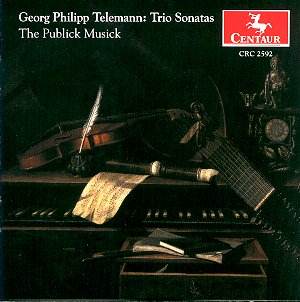By the time he was twenty years old Telemann had mastered
French and Italian composition styles as a result of visits to the Brunswick
and Hannover courts, and had founded the Leipzig Collegium Musicum while
serving there as director of the Opera and Neukirche. In 1709 he was
appointed Kapellmeister and Secretary to Duke Johann Wilhelm at Eisenach.
In the following years he visited nearby Weimar where he began his lifelong
friendship with J. S. Bach, and wrote these trios. These works are remarkable
in that, while they display mastery of existing musical styles, they
are not in what would become Telemannís mature composition style. He
could conceivably have played them on the violin accompanied by Bach
at the keyboard, with Pisendel, Volumier, or any of the other notable
musicians who were among his friends. These works are most reminiscent
of Corelli, and those involving the flute are likely to be the ones
praised by Quantz in his 1752 flute treatise. They are recorded here
for the first time.
When listening to yet another disk of excellent Telemann
excellently played, of all the adjectives that go through oneís mind,
the one that seemed to stick most firmly was "delectable."
Of particular note is the wooden Baroque transverse flute playing which
was expressive and firm of tone and the excellent harpsichord playing
of James Bobb. These are tense performances in high OI/OPPI* style with
crisp accents and brisk tempi and no trace whatever of vibrato but the
lyrical slow movements are played with great affect and feeling.
The notes and tray liner continue the general trend
towards smaller and smaller type, so on your way to the record shop
pick up a magnifying glass, too.
*Original Instruments/Original Performance Practice
Informed
Paul Shoemaker

